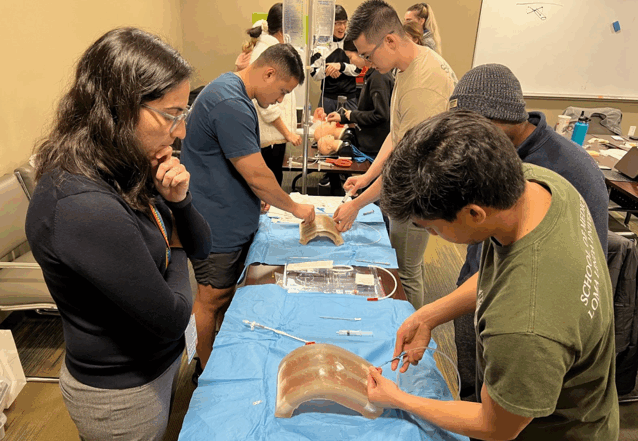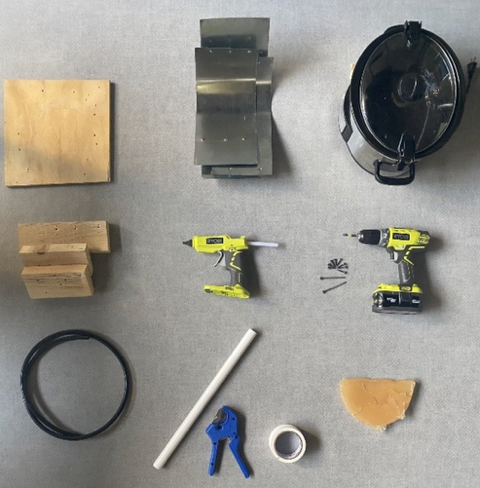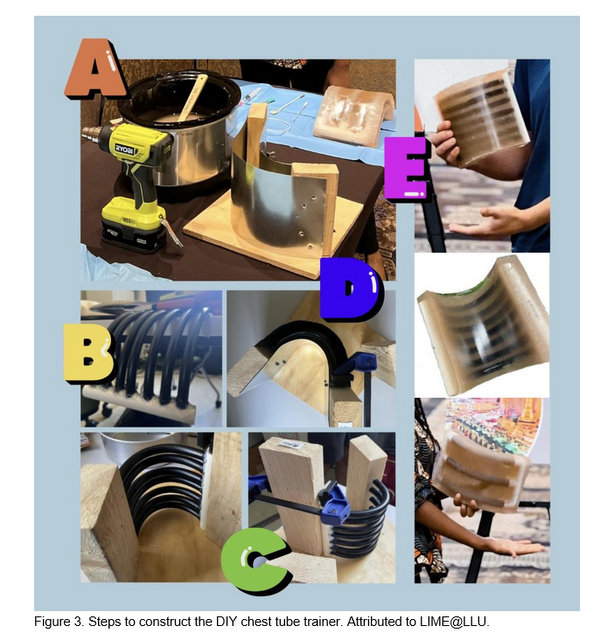Chest tube insertion is a high-risk procedure that occurs with relatively high frequency in the emergency department. Emergency medicine (EM) graduates need to be prepared to place a chest tube. The ACGME requires EM residents to complete at least ten tube thoracostomies as part of their training. Commercial simulation trainers and cadavers have been used to provide EM trainees with opportunities to practice chest tube placement.1
Simulation training models have proven to be useful and effective teaching tools for other medical skills; however, they can be cost prohibitive for some programs.2
Slabs of animal ribs have been used to practice chest tube placement, but they are messy and can generally only be used once.3 We have previously created a homemade thoracostomy trainer called “Yogaman” and have used it to provide more opportunities to practice open chest tube placement.4
Seldinger chest tube placement has become more common in recent years and is replacing open chest tube placement in certain clinical scenarios.5 It is important that EM residents have opportunities to practice this type of chest tube placement as well, since it differs in many ways from open chest tube placement.
Practicing emergency physicians who trained in an era where Seldinger chest tubes were placed less commonly may also wish to practice to improve their skills. We have had success using ballistics gel for training models, as it is relatively inexpensive and can be remelted and reformed.6 With this in mind, we created a low-cost, reusable trainer for Seldinger chest tube placement using polyvinyl chloride (PVC) pipe and ballistics gel.
We created the trainer by making a mold from wood and sheet metal (figure 1). We made the mold curved so that the trainer naturally creates an airspace underneath it that is the target space for the tube. We first made a model with wider set ribs. Because we often use Seldinger chest tubes for children, we then decided to refine the model to better simulate a child’s rib cage. We aimed for realistic rib spacing and chest wall thickness (CWT). We settled on an intercostal spacing of 1.2 cm and a CWT of 2.5 cm based on available measurements and in order to accommodate our PVC pipe.7
We have used our model with medical students, emergency medicine residents, pediatric emergency medicine fellows, and emergency medicine faculty, both at our institution as well as at a national conference. We have received positive feedback about the trainer, with users commenting that they appreciated the chance to practice a complex procedure for which there are not other good options for practice. The simplicity and reusability of the trainer was also appreciated.
Unlike the first model we made, which used PVC tees and elbows to connect the simulated ribs, we drilled the PVC in the second version and inserted semi-rigid rubber tubing into the holes. The intercostal spaces can thus be modified to fit the patient population of interest. The “core materials” that we used to make the trainer were gaffer tape, ballistics gel, and a slow cooker.
Though ballistics gel dye is not required for the trainer to be effective, the increased opacity and lifelike colors result in a more realistic simulation experience. These core materials are an initial investment but can act as a starting toolkit for individuals seeking to create other low-cost simulation models.
Steps to Construct the Chest Model
- Set the slow cooker to low and begin melting the ballistics gel (A). Rip or cut the ballistics gel into small pieces so that it melts faster. Allow it to melt for 2-3 hours.
- Cut seven equal 9-inch pieces of rubber tubing.
- Drill seven ½ inch holes using a ½ inch drill bit 1.2 cm apart into two 8-inch-tall PVC pipes.
- Insert the rubber tubing into each hole and hot glue each rubber tube into its respective hole to allow for increased stability. Bend the rubber tubing to your desired curvature (B).
- Stabilize the curved PVC rib model between two slabs of wood with two clamps (C).
- Carefully cut two equal 8.5 x 13-inch pieces of sheet metal. Use protective gloves.
- On a plywood base, stand the PVC rib model upright. Following the curvature of the ribs, drill a 2×4 inch block at either end of the plywood.
- Once the structure is stable, curve one piece of sheet metal around the outside of the rib model, staying close to the curvature of the tubing. Allow the edge of the sheet metal to overlap the wooden block. Drill into the top, middle, and bottom edges of the sheet metal to anchor it to the 2×4 blocks. Repeat this on the other side to create the outer shell of the mold (D)
- Curve the other piece of sheet metal into the inner surface of the rib model, staying close to the curvature, allowing some of the sheet metal to overlap the 2×4 blocks on the inner surface. Drill screws as in step 6 to anchor the sheet metal onto the block to create the inner surface of the mold.
- Apply gaffer tape along the junction of the sheet metal mold and the wooden base to prevent leakage.
- Carefully pour the hot ballistics gel into the mold. Allow several hours to cool.
- Once cool, begin dismantling the mold by peeling the tape off the bottom, then removing the screws that anchor the sheet metal to the wooden blocks and the screws that anchor the wooden blocks to the wooden base.
- Remove the wooden blocks and carefully peel the sheet metal off the model. The chest tube model is now ready to use (E)!
- Use a heat gun or hair dryer to remelt and seal holes made in the model during training.
Core Materials for This Model that Can be Used for Other Trainers
| Item | Link | Price |
| Ballistic Gel | https://clearballistics.com/shop/10-gel-fbi-block/ | $90 |
| Slow Cooker | www.amzn.com/B003OAJGJO/ | $48 |
| Ballistic Gel Dye | http://humimic.com/product-category/dye/ | $38 |
| Aluminum Foil | www.amzn.com/B005GPJCHQ/ | $3 |
| Heat Safe Tape | www.amzn.com/B00GZE3UJ8 | $20 |
| Total | $199 |
Required Materials for Chest Tube Trainer
| Item | Link | Price |
| 1 inch PVC pipe | https://www.lowes.com/pd/Charlotte-Pipe-1-in-dia-x-10-ft-L-200-PSI-SDR-21-PVC-Pipe/1000080801 | $6 |
| Rubber piping | https://www.lowes.com/pd/EZ-FLO-1-4-in-Inner-Diameter-x-10-ft-Rubber-Fuel-Hose/1000180619 | $9 |
| PVC Cutter | https://www.lowes.com/pd/Kobalt-1-1-4-in-PVC-Cutter/1002600024 | $18 |
| Electric Drill | https://www.homedepot.com/p/RYOBI-ONE-18V-Cordless-3-8-in-Drill-Driver-Kit-with-1-5-Ah-Battery-and-Charger-PCL201K1/326680222 | $50 |
| Half inch drill bit | https://www.homedepot.com/p/Milwaukee-SHOCKWAVE-1-2-in-Titanium-Twist-Drill-Bit-48-89-4629/205879022 | $23 |
| Screws | https://www.lowes.com/pd/Fas-n-Tite-6-x-1-1-4-in-Bugle-Coarse-Thread-Drywall-Screws-1-lb/999996482 | $8 |
| Hot glue gun | https://www.homedepot.com/p/RYOBI-ONE-18V-Cordless-Full-Size-Glue-Gun-Tool-Only-with-3-General-Purpose-Glue-Sticks-P305/300335930?source=shoppingads&locale=en-US | $20 |
| Hot glue sticks | https://www.homedepot.com/p/Arrow-10-in-x-1-2-in-Dia-All-Purpose-Clear-Full-Size-Glue-Sticks-12-Pack-AP10-4/100048796 | $8 |
| Plywood | https://www.lowes.com/pd/1-2-in-Birch-Plywood-Application-as-2-x-2/1000066183 | $17 |
| 2×4 Blocks | https://www.lowes.com/pd/Top-Choice-2-in-x-4-in-x-8-ft-Douglas-Fir-Stud-Common-1-5-in-x-3-5-in-x-96-in-Actual/1000363761 | $4 |
| Steel sheet | https://www.lowes.com/pd/IMPERIAL-16-in-x-36-in-Galvanized-Steel-Joist-Lining/3134385 | $11 |
| Protective gloves | https://www.lowes.com/pd/Blue-Hawk-BH-LEATHER-PALM-GLOVE-W-SAFETY-CUFF/1002950458 | $5 |
| Total | $179 |
References
-
- Tan TX, Buchanan P, Quattromani E. Teaching Residents Chest Tubes: Simulation Task Trainer or Cadaver Model? Emerg Med Int. 2018;2018:9179042.
- Sao Pedro T, Mtaweh H, Mema B. More Is Not Always Better in Simulation. Learners’ Evaluation of a “Chest Model.” ATS Sch. 2020;2(1):124-133.
- Van Doormaal CJ, Howes DW, Salazar CL, Parker CM. 112 an innovative and inexpensive pork ribs model for teaching tube thoracostomy. Ann Emerg Med. 2011;58(4):S215.
- Young TP, Schaefer MD, Kuntz HM, et al. Yogaman: An Inexpensive, Anatomically-detailed Chest Tube Placement Trainer. West J Emerg Med. 2019;20(1):117-121.
- McElnay PJ, Lim E. Modern Techniques to Insert Chest Drains. Thorac Surg Clin. 2017;27(1):29-34.
- Ware PJ, Bitange P, Cooper GJ, et al. Train Yourself: Putting your best foot forward. Emergency Physicians Monthly | Independent news and analysis in emergency medicine. March 6, 2024. Accessed August 20, 2025. https://epmonthly.com/article/train-yourself-putting-your-best-foot-forward/
- Leonhard G, Overhoff D, Wessel L, et al. Determining optimal needle size for decompression of tension pneumothorax in children – a CT-based study. Scand J Trauma Resusc Emerg Med. 2019;27(1):90.





